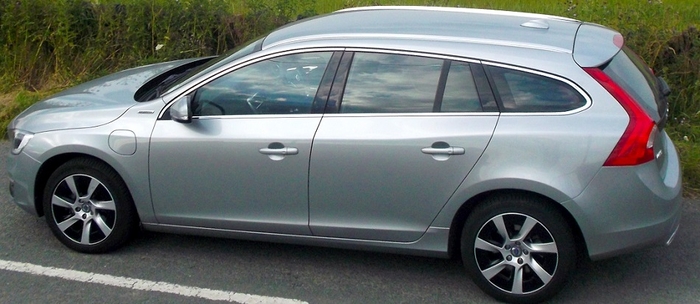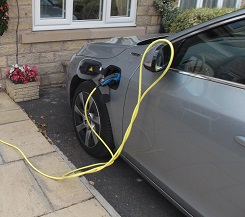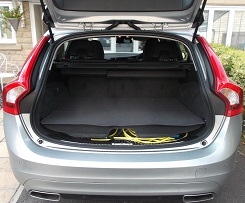Volvo V60 Plug-in Hybrid

Now this car really is a conundrum, and it’s hard to know where to start with it. It is very confusing, brilliant and yet slightly disappointing at the same time.

This V60 is powered by Volvo’s D6 powertrain, which consists of the 2.4 litre 5 cylinder 215hp diesel engine from their D5 models, coupled to a 50kwh/70hp electric motor. The engine powers the front wheels, and the electric motor powers the rear. All this power does make it a quick car, despite carrying around some hefty Lithium-Ion batteries; it still accelerates from 0 - 62mph in 6.1 seconds, and has a top speed of 143mph, so it’s no slouch.
The quality throughout is to a very high standard and lots of nice, careful detail has gone into most of the car. The attention and craftsmanship really is superb throughout. The seats are comfortable and there is loads of room for three adults in the rear. Luggage space is slightly compromised with a higher than normal floor, due to the batteries being under the cargo area.
 Now for the tricky bit: Volvo’s figures, on paper they look really impressive. But in reality these are not really Volvo’s figures, but produced for them, following European standards and tests, in a controlled environment, that don’t really bear any resemblance to real life conditions. With these tests no doubt being dreamt up by some boffin in Brussels, who probably drinks strong Leffe beer and doesn’t go out much and who thought it was a really good idea. The combined fuel consumption figure in the brochure is 155.2 mpg with CO2 emissions at 48g/km. It has a range of up to 560 miles in hybrid mode and a range of up to 31 miles on pure electric.
Now for the tricky bit: Volvo’s figures, on paper they look really impressive. But in reality these are not really Volvo’s figures, but produced for them, following European standards and tests, in a controlled environment, that don’t really bear any resemblance to real life conditions. With these tests no doubt being dreamt up by some boffin in Brussels, who probably drinks strong Leffe beer and doesn’t go out much and who thought it was a really good idea. The combined fuel consumption figure in the brochure is 155.2 mpg with CO2 emissions at 48g/km. It has a range of up to 560 miles in hybrid mode and a range of up to 31 miles on pure electric.
Now for reality: after a week of using the V60 and charging it at home four times. To take the range from zero to 30 miles takes around 6 hours of charging. The thick yellow cable had to go into the house through the front door, and consequently the door wouldn’t close, so it couldn’t be charged overnight (well it could, but the door would have had to be left open). All that was heard from “the boss” was “when can we shut the door” or “how long does the door have to stay open” – and those are the polite versions. The 6 hours of charging probably cost around £2.
We have used the V60 quite a bit over the past few days, down to Luton and Gatwick, and running around home, but the vast majority on the M1 and M25. We reset the trip computer when the car was delivered and we have covered 868.6 miles over 19 hours 40 minutes of of driving. The average miles per gallon over this distance was 42.2mpg. This is absolutely nowhere near the 155.2mpg quoted and very disappointing. When the tank was filled to the brim, it only registered a range of 340 miles, way off the stated 560 miles.

Anyone buying a Plug-In Hybrid has to remember it is quite possible to get much more than 155.2 mpg. Imagine: Plug it in every night, go 30 miles the next day, just commuting to work, shopping or to see friends. Do that for month after month, the diesel engine will never fire-up, and it is possible to get 1000 mpg without really trying, just keep it charged up, and don’t go very far.
There is a really useful button simply called “save” – you press this when you want to reserve the battery power for later, and you can then switch on to pure electric power when you need it. The pure electric mode is great if you are in congestions and doing a lot of stopping and starting, or if you just want to be green and eco-friendly, but we also found it useful when going out of the drive early in the morning and especially useful when you want to creep in home at night when you don’t want to wake anybody. It is absolutely silent with the diesel engine shut off.
Any manufacturer who sells this type of car really does have to manage customer’s expectations and I am sure Volvo and others would really like to put in some caveats, and explanations as to how these misleading (both ways- they can be much higher, and much lower) figures are arrived at, but they can’t, so don’t.
There are numerous safety features, too many to mention. There are warning lights and buzzers for just about every conceivable danger or hazard.
 The V60 Plug-In Hybrid is perfect in an ideal world. You really need the free wall-box that Volvo supply so the cable does not intrude into your home. Your journeys need to be blended so that you get the full benefit of the electric side of the powertrain. This may well involve finding and using some of the free charging points that are along or nearby to your regular routes. But ultimately you have two cars in one, an efficient electric car for short trips and a comfortable long haul cruiser.
The V60 Plug-In Hybrid is perfect in an ideal world. You really need the free wall-box that Volvo supply so the cable does not intrude into your home. Your journeys need to be blended so that you get the full benefit of the electric side of the powertrain. This may well involve finding and using some of the free charging points that are along or nearby to your regular routes. But ultimately you have two cars in one, an efficient electric car for short trips and a comfortable long haul cruiser.
It would be better for manufactures to be allowed to give more accurate fuel consumption figures based on a variety of journeys, and usage, then customers would have a better and clear understanding of what they may achieve in their real life situations.
There are now two trim levels on offer as opposed to the original single specification Pure version, the SE Lux at £49975.00 OTR and the R-Design Lux at £51675.00 OTR, although you can reduce these by £5000.00 straight away thanks to the Government Plug-In car grant. But you have to bear in mind that you can have a D3 SE Lux for £31995.00 OTR, which would save you nearly £13,000.00 and this has a combined fuel consumption of 62.8 MPG and a CO2 figure of 119g/km.
Martin Ward, Manufacturer Relationship Manager


